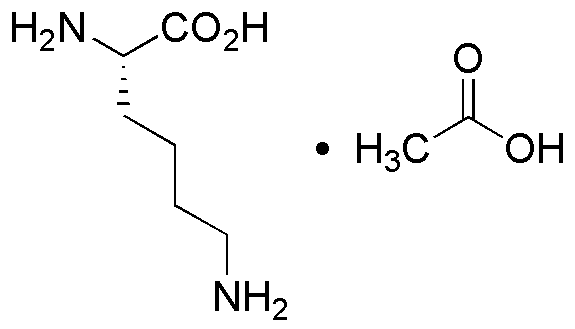L-Lysine acetate salt is widely utilized in research focused on:
- Nutritional Supplements: Commonly used in dietary formulations to support muscle growth and recovery, particularly for athletes and bodybuilders.
- Pharmaceuticals: Acts as a buffering agent in medications, enhancing stability and efficacy, especially in injectable formulations.
- Animal Feed: Added to livestock feed to promote growth and improve overall health, contributing to better feed conversion ratios.
- Cosmetics: Incorporated in skincare products for its moisturizing properties, helping to improve skin hydration and elasticity.
- Biotechnology: Used in cell culture media to support the growth of various cell lines, crucial for research and development in pharmaceuticals and vaccine production.
General Information
Properties
Safety and Regulations
Applications
L-Lysine acetate salt is widely utilized in research focused on:
- Nutritional Supplements: Commonly used in dietary formulations to support muscle growth and recovery, particularly for athletes and bodybuilders.
- Pharmaceuticals: Acts as a buffering agent in medications, enhancing stability and efficacy, especially in injectable formulations.
- Animal Feed: Added to livestock feed to promote growth and improve overall health, contributing to better feed conversion ratios.
- Cosmetics: Incorporated in skincare products for its moisturizing properties, helping to improve skin hydration and elasticity.
- Biotechnology: Used in cell culture media to support the growth of various cell lines, crucial for research and development in pharmaceuticals and vaccine production.
Documents
Safety Data Sheets (SDS)
The SDS provides comprehensive safety information on handling, storage, and disposal of the product.
Product Specification (PS)
The PS provides a comprehensive breakdown of the product’s properties, including chemical composition, physical state, purity, and storage requirements. It also details acceptable quality ranges and the product's intended applications.
Certificates of Analysis (COA)
Search for Certificates of Analysis (COA) by entering the products Lot Number. Lot and Batch Numbers can be found on a product’s label following the words ‘Lot’ or ‘Batch’.
*Catalog Number
*Lot Number
Certificates Of Origin (COO)
This COO confirms the country where the product was manufactured, and also details the materials and components used in it and whether it is derived from natural, synthetic, or other specific sources. This certificate may be required for customs, trade, and regulatory compliance.
*Catalog Number
*Lot Number
Safety Data Sheets (SDS)
The SDS provides comprehensive safety information on handling, storage, and disposal of the product.
DownloadProduct Specification (PS)
The PS provides a comprehensive breakdown of the product’s properties, including chemical composition, physical state, purity, and storage requirements. It also details acceptable quality ranges and the product's intended applications.
DownloadCertificates of Analysis (COA)
Search for Certificates of Analysis (COA) by entering the products Lot Number. Lot and Batch Numbers can be found on a product’s label following the words ‘Lot’ or ‘Batch’.
*Catalog Number
*Lot Number
Certificates Of Origin (COO)
This COO confirms the country where the product was manufactured, and also details the materials and components used in it and whether it is derived from natural, synthetic, or other specific sources. This certificate may be required for customs, trade, and regulatory compliance.


